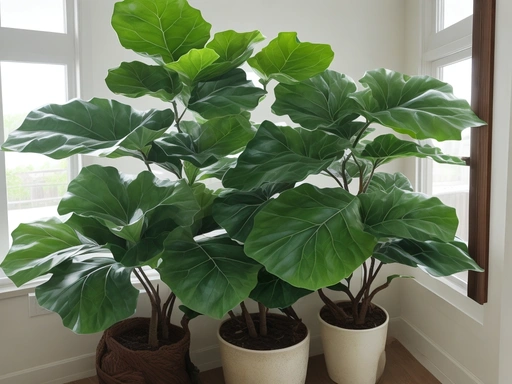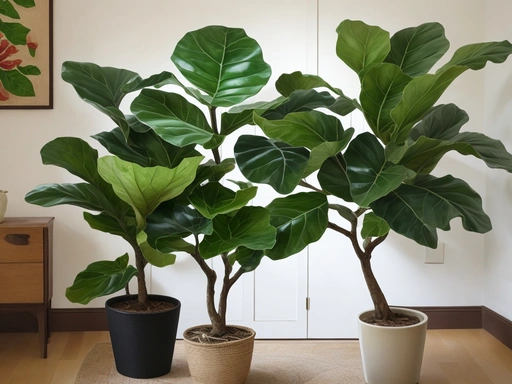Fiddle-Leaf Fig And Air Purification Benefits for a Healthier Home
Key Takeaways:
- Fiddle-leaf figs can improve indoor air quality by removing toxins and pollutants.
- These plants release oxygen and promote better air circulation, reducing the risk of respiratory issues.
- Fiddle-leaf figs are low-maintenance and thrive in low and bright light conditions.
- Besides air purification, they can enhance the aesthetic appeal and add a touch of green to any space.
Are you looking for a stylish and effective way to improve the air quality in your home? Look no further than the fiddle-leaf fig plant.
Not only does this trendy houseplant add a touch of natural beauty to any space, but it also has impressive air purification benefits.
With its high transpiration rate and ability to filter toxins, the fiddle-leaf fig is a powerhouse when it comes to cleansing the air. In this article, we’ll explore the features and care tips for this popular plant and its role in improving indoor air quality.
Get ready to breathe easier with the fiddle-leaf fig!
| Fiddle-leaf Fig | Air Purification Benefits |
|---|---|
| Scientific Name: Ficus lyrata | |
| Common Name: Fiddle-leaf fig | |
| Family: Moraceae | |
| Origin: Western Africa | |
| Light Requirements: Bright, indirect light | |
| Watering: Moderate | |
| Height: Up to 10 feet | |
| Foliage: Large, glossy, violin-shaped leaves | |
| Air Purification Benefits: | |
| 1. Removes airborne toxins | |
| 2. Enhances indoor air quality | |
| 3. Filters formaldehyde, xylene, and toluene |
What is a Fiddle-Leaf Fig?
The Fiddle-Leaf Fig is a popular houseplant known for its large, glossy leaves and elegant appearance. It is native to tropical regions and is often chosen to add a touch of greenery and style to indoor spaces.
Overview of the Fiddle-Leaf Fig plant
The Fiddle-Leaf Fig is a popular indoor plant known for its large, violin-shaped leaves. It is native to the tropical regions of Africa and can grow up to 10 feet tall.
This plant has a unique aesthetic appeal and is often used as a statement piece in interior design.
Its striking appearance and ease of care make it a favorite among plant enthusiasts.
Features and characteristics of the Fiddle-Leaf Fig plant
The fiddle-leaf fig is a popular indoor plant known for its large, glossy leaves that resemble the shape of a violin or fiddle.
It can grow up to 10 feet tall and has a distinctive tropical appearance.
This plant is native to the rainforests of West Africa and thrives in bright, indirect light.
The fiddle-leaf fig requires regular watering and prefers well-draining soil.
It is a slow-growing plant and can be a bit finicky to care for, but with the right conditions, it can make a stunning addition to any indoor space.
Indoor Plants and Air Purification
Indoor plants can effectively purify the air in your home, creating a healthier and more pleasant environment.
Benefits of indoor plants for air purifying
Indoor plants have several benefits for air purification.
They can remove harmful toxins, improve air quality, and increase oxygen levels.
Plants also release moisture, which helps to humidify the air and reduce the risk of respiratory issues.
Additionally, they can absorb carbon dioxide and release oxygen, creating a healthier environment for us to breathe.
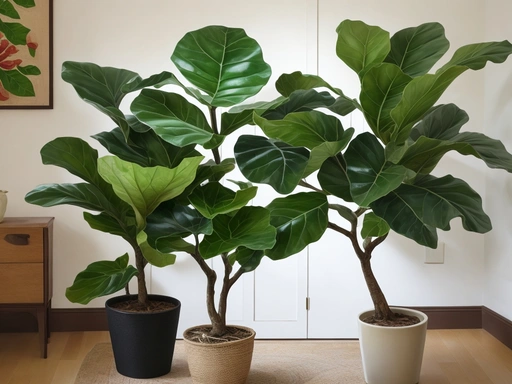
Popular indoor plants for air purification
Indoor plants can be great allies in purifying the air in your home.
Some popular indoor plants for air purification include:
- Spider Plant: Known for its ability to remove formaldehyde and xylene from the air.
- Snake Plant: Helps to filter out toxins like benzene, formaldehyde, trichloroethylene, and xylene.
- Peace Lily: Removes common indoor pollutants like benzene, formaldehyde, and trichloroethylene.
- English Ivy: Effective at reducing airborne mold spores and filtering out formaldehyde.
- Aloe Vera: Helps to clear the air of formaldehyde and benzene, which are commonly found in cleaning products.
These plants not only add beauty to your space but also improve air quality, making them a worthwhile addition to your indoor environment.
Role of Fiddle-Leaf Fig in air purification

The Fiddle-Leaf Fig plays a significant role in air purification.
It has a high transpiration rate, which means it releases moisture into the air, helping to increase humidity.
This can reduce the levels of airborne pollutants and improve air quality.
Additionally, the leaves of the Fiddle-Leaf Fig have the ability to filter toxins, further enhancing its air purification capabilities.
Overall, this plant is effective in reducing indoor pollutants and creating a healthier environment.
How indoor plants improve air quality
Indoor plants improve air quality by releasing oxygen and absorbing carbon dioxide during photosynthesis.
They also remove toxins like formaldehyde and benzene from the air.
Plants increase humidity, reduce dust, and can even help to control temperature.
They create a healthier and more pleasant environment for us to breathe in.
Why Fiddle-Leaf Fig is Great for Air Purification
The Fiddle-Leaf Fig is a great plant for air purification due to its high transpiration rate and its ability to filter toxins from the air.
High transpiration rate of the Fiddle-Leaf Fig
The Fiddle-Leaf Fig has a high transpiration rate, meaning it releases a lot of moisture into the air through its leaves. This helps to increase humidity levels in your home, which can be beneficial for your overall indoor air quality.
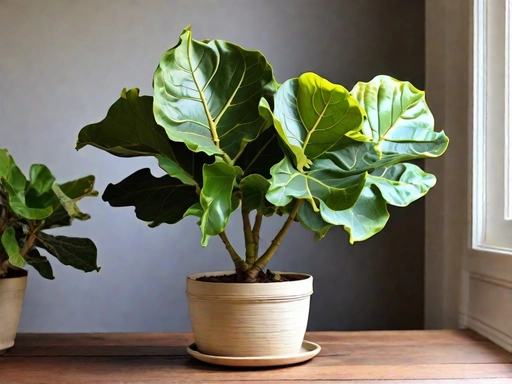
Ability of Fiddle-Leaf Fig to filter toxins
The Fiddle-Leaf Fig has the ability to filter toxins from the air, making it a great choice for improving indoor air quality. It is known for its effectiveness in removing pollutants such as formaldehyde, benzene, and trichloroethylene.
The plant’s large leaves and dense foliage help in absorbing these harmful substances and converting them into oxygen.
This natural air purification ability of the Fiddle-Leaf Fig makes it a valuable addition to any indoor space.
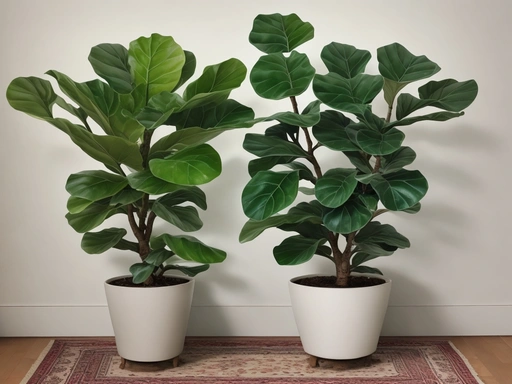
Effectiveness of Fiddle-Leaf Fig in reducing airborne pollutants
The Fiddle-Leaf Fig is effective in reducing airborne pollutants. It has a high transpiration rate, which means it releases a lot of moisture into the air.
This helps to trap and remove pollutants, such as dust and toxins.
Additionally, the leaves of the plant act as natural filters, purifying the air and improving its quality. The Fiddle-Leaf Fig is a great choice for enhancing indoor air purification.
Care Tips for Your Fiddle-Leaf Fig
To properly care for your Fiddle-Leaf Fig, consider its ideal growing conditions, watering and humidity needs, soil and fertilization requirements, as well as its preferences for sunlight and temperature.
Ideal growing conditions for Fiddle-Leaf Fig
The ideal growing conditions for a Fiddle-Leaf Fig are bright, indirect light and moderate humidity.
It thrives in temperatures between 60-75°F (15-24°C).
Use well-draining soil and water when the top inch of soil is dry.
Avoid placing it in drafty areas or direct sunlight, as it can lead to leaf damage.
A stable and consistent environment will help your Fiddle-Leaf Fig grow happily.
Watering and humidity needs of Fiddle-Leaf Fig
Water your Fiddle-Leaf Fig when the top inch of soil is dry. Give it a thorough watering until water drains from the bottom of the pot.
Avoid overwatering to prevent root rot.
Mist the leaves occasionally to maintain humidity, as the plant prefers higher humidity levels.
Soil and fertilization requirements for Fiddle-Leaf Fig
The Fiddle-Leaf Fig thrives in well-draining soil that retains moisture.
A mix of peat moss, perlite, and sand works well.
Fertilize once a month during the growing season with a balanced liquid fertilizer.
Avoid over-fertilizing, as it can lead to leaf burn.
Regularly check the moisture level and adjust watering accordingly.
Sunlight and temperature preferences for Fiddle-Leaf Fig
The Fiddle-Leaf Fig thrives in bright, indirect sunlight, making it ideal for a south or west-facing window. It prefers temperatures between 65-75°F (18-24°C) during the day and slightly cooler temperatures at night.
Avoid exposing it to drafts or sudden temperature fluctuations.
Best Practices for Using Fiddle-Leaf Fig as an Air Purifier
To get the most out of your fiddle-leaf fig as an air purifier, here are some best practices to follow.
Placement of Fiddle-Leaf Fig for optimal air purification
To maximize air purification benefits, place your fiddle-leaf fig in an area with good airflow. Avoid placing it near drafts or vents, as it may lead to stress for the plant.
Ideally, choose a spot where it can receive indirect sunlight and maintain a consistent temperature.
Regularly dust the leaves to ensure optimal air purification.
Grouping indoor plants for enhanced air quality
To enhance air quality, group indoor plants together in close proximity.
This allows them to create a microclimate that increases humidity and promotes better air circulation.
Grouping plants also maximizes their combined air-purifying effects, making your indoor environment healthier and more enjoyable.
Additionally, it’s important to choose plants with varying filter capabilities to target a wider range of pollutants.
Remember to consider each plant’s specific care needs when creating your indoor plant groupings.
Maintenance and cleaning of Fiddle-Leaf Fig for better air purification
To maintain and clean your Fiddle-Leaf Fig for better air purification, here are some tips:
- Dust the leaves regularly with a soft cloth or sponge to remove any buildup of dust and dirt. This will help the leaves to breathe and enhance their air-purifying capabilities.
- Use a mild, organic insecticidal soap to get rid of any pests that may be affecting your plant. Be sure to follow the instructions carefully and avoid using harsh chemicals that can harm the plant and compromise its ability to purify the air.
- Trim off any yellow or brown leaves to promote healthy growth and ensure the plant’s vitality. This will also prevent any dead leaves from becoming breeding grounds for bacteria or mold, which can negatively impact indoor air quality.
- Clean the pot and surrounding area to prevent the buildup of mold or fungus. Wipe down the pot with a damp cloth or sponge and remove any fallen leaves or debris around the plant.
- Monitor the moisture levels of the soil and water your Fiddle-Leaf Fig accordingly. Overwatering can lead to root rot and affect the plant’s overall health, while underwatering can cause the leaves to dry out and lose their air-purifying properties.
Frequently Asked Questions
Can Fiddle-Leaf Fig eliminate all indoor pollutants?
No, the Fiddle-Leaf Fig cannot eliminate all indoor pollutants. While it does have air purifying properties, it is not capable of completely eliminating all pollutants on its own.
It primarily helps to improve air quality by filtering certain toxins and releasing oxygen.
To effectively purify your indoor air, it is recommended to use a combination of plants, proper ventilation, and other air purifying methods.
Are Fiddle-Leaf Figs safe for households with pets?
Fiddle-Leaf Figs (Ficus lyrata) can be toxic to pets if ingested. The leaves and sap contain chemicals that can cause gastrointestinal upset, vomiting, and diarrhea in dogs and cats.
It’s best to keep these plants out of reach of pets or opt for pet-friendly plants instead.
How long does it take for a Fiddle-Leaf Fig to purify the air?
A Fiddle-Leaf Fig can start purifying the air in your home within a few days, but the full effects may take a few weeks or even months to notice.
The time it takes depends on factors like the size of the plant, the number of plants in the space, and the level of air pollution.
What are some common issues faced while caring for a Fiddle-Leaf Fig?
Caring for a Fiddle-Leaf Fig can come with its fair share of challenges. Some common issues include overwatering, underwatering, low humidity, lack of sunlight, yellowing leaves, and pests like spider mites.
It’s important to find the right balance of water, light, and humidity to keep your Fiddle-Leaf Fig healthy and thriving.
Regularly inspecting the leaves for any signs of damage or pests can also help prevent potential issues.
Final Verdict
The fiddle-leaf fig is a remarkable indoor plant that not only adds natural beauty to your space but also plays a vital role in purifying the air.
Its high transpiration rate, ability to filter toxins, and effectiveness in reducing airborne pollutants make it an excellent choice for improving the air quality in your home or office.
By providing ideal growing conditions, proper care, and strategic placement, you can maximize the air purification benefits of your fiddle-leaf fig.
So, go ahead and invite this beautiful and efficient air purifier into your space for a healthier and cleaner environment.


